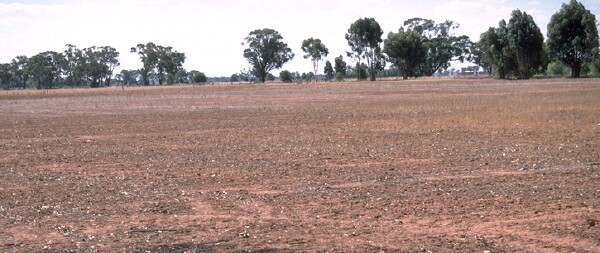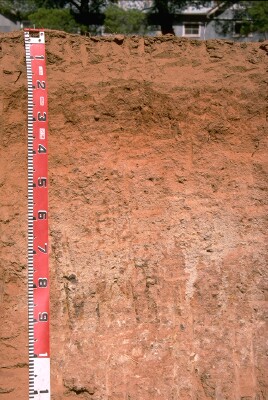LP34
| Group: Bridgewater Farm Advance | Australian Soil Classification: Haplic, Eutrophic, Red KANDOSOL |
| Northcote Factual Key:Um 5.52 | Great Soil Group: red earth |
| General Landscape Description: Higher position on flat plain. The original vegetation included Grey Box (Eucalyptus microcarpa). | |
 Lp34 Landscape |
Soil Profile Morphology
Surface Soil
| A1 | 0-15 cm | Reddish brown (5YR4/4); light sandy clay loam; hardsetting surface condition; massive; firm consistence dry; pH 5.5; clear change to: |  LP34 Profile |
| Subsoil | |||
| B21 | 15-35 cm | Red (2.5YR4/8); light sandy clay loam; massive to weakly structured (earthy fabric); strong consistence dry; pH 6.8; clear change to: | |
| B22 | 35-70 cm | Strong brown (7.5YR5/6); light sandy clay loam; weakly structured; very firm consistence dry; contains quartz grit and a few (2-10%) ferromanganiferous nodules; pH 7.7; gradual change to: | |
| B23 | 70-110+ cm | Reddish brown (5YR4/4); sandy clay loam; weakly structured; strong consistence dry; contains quartz grit and a few (2-10%) ferromanganiferous nodules; pH 7.5. | |
Key Profile Features
- Lack of strong texture contrast between the surface (A) horizons (clay content 15%) and the clay (B) subsoil (clay content 15%).
- Hardsetting surface soil, with a high fine sand content (49%).
Key Profile Characteristics
pH | Salinity Rating | |||
Surface (A1 horizon) | strongly acid | very low | non-sodic | none1 |
Subsoil (B21 horizon) | slightly acid | very low | non-sodic | none2 |
Deeper subsoil (at 90 cm) | slightly alkaline | very low | non-sodic | none |
| 1 Slight dispersion after remoulding. 2 Strong dispersion after remoulding. | ||||
 |
Management Considerations:
Surface (A) Horizon
- When cultivated dry, these soils will become "powdery" and may then be prone to crusting if heavy rains occur.
- The surface soil slakes when rapidly wet and will be susceptible to surface crust formation and hardsetting. The organic carbon levels are low which will also promote slaking. Slaking can be reduced by increasing organic matter levels in the surface soil. Organic matter reduces slaking by binding soil particles together and by reducing the rate of wetting of the soil. Tillage should be minimised and stubble retention/pasture rotations practised.
- The surface soil disperses slightly after remoulding which indicates that mechanical disturbance to this horizon whilst in a moist condition may result in some structural degradation.
- The surface soil has a low overall nutrient status. The total nitrogen levels are also relatively low compared to other sites in the area.
- The laboratory analysis indicates that the surface soil has a low plant available water holding capacity. Improving organic matter levels will assist improving water holding capacity as well as soil fertility.
- The strongly acid surface horizon indicates that aluminium and manganese toxicity may occur. Raising the pH level of the soil will help reduce any toxic effects. A lime test (at the paddock level) may be appropriate to determine the amount of lime required.
Subsoil (B) Horizons
- The laboratory results indicate that plant available water capacity is low for the subsoil.
- The overall nutrient status is low for the subsoil.
- The subsoil is non-sodic and profile drainage is likely to be very good.
Notes
- Profile described by Mark Imhof, Paul Rampant and Sonia Thompson (14/2/95)


